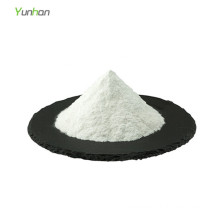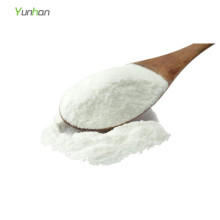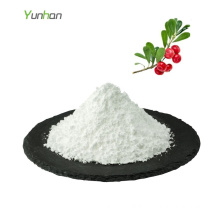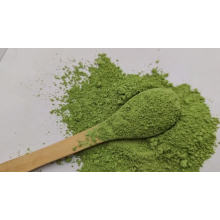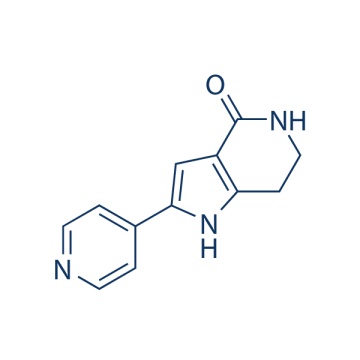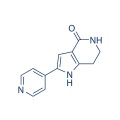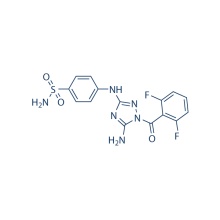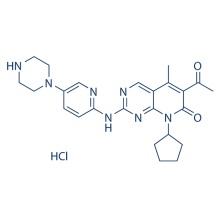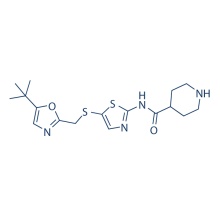PHA-767491 845714-00-3
Product Description
.cp_wz table {border-top: 1px solid #ccc;border-left:1px solid #ccc; } .cp_wz table td{border-right: 1px solid #ccc; border-bottom: 1px solid #ccc; padding: 5px 0px 0px 5px;} .cp_wz table th {border-right: 1px solid #ccc;border-bottom: 1px solid #ccc; padding: 5px 0px 0px 5px;}
Molecular Weight:
213.24 PHA-767491 is a potent ATP-competitive dual Cdc7/CDK9 inhibitor with IC50 of 10 nM and 34 nM, respectively.It displays ~20-fold selectivity against CDK1/2 and GSK3-β, 50-fold selectivity against MK2 and CDK5, 100-fold selectivity against PLK1 and CHK2.
Biological Activity
PHA-767491 displays approximately 20-fold selectivity for Cdk1, Cdk2 and
GSK3-β, 50-fold selectivity for MK2 and Cdk5 and 100-fold selectivity
for PLK1 and CHK2. PHA-767491 inhibits cell proliferation in a variety
of human cell lines with IC50 of 0.86 μM for SF-268 to 5.87 μM for K562,
and significantly induces Apoptosis in a p53-independent manner in
almost all cell lines in contrast with 5-FU or gemcitabine which only
works in a few of cell lines. Unlike current DNA Synthesis Inhibitors,
PHA-767491 treatment at 5 μM blocks the initiation of DNA replication
but not replication fork progression, due to specific inhibition of Cdc7
kinase and Mcm2 phosphorylation at the Cdc7-dependent Ser40 site.
The
up-regulated Mcl-1 levels in ABT-737-resistant OCI-LY1 and SU-DHL-4
cells can be significantly decreased by PHA-767491 treatment at 3 μM
possibly due to the inhibition of Cdk9, leading to the restoration of
the sensitivity to ABT-737. The direct mitochondrial dependent
pro-apoptosis effect of PHA-767491 is also observed when applied at 1 μM
in quiescent chronic lymphocytic leukemia (CLL) cells through the
similar mechanism with EC50 of 0.34-0.97 μM. While in proliferating CLL
cells stimulated by CD154 and interleukin-4, PHA-767491 treatment at 5
μM abolishes DNA synthesis by inhibiting Cdc7 rather than triggering
cell death.
Administration of PHA-767491 twice a day for 5 days significantly
inhibits the growth of HL60 xenograft in a dose-dependent manner with
TGI of 50% and 92% at dose of 20 mg/kg and 30 mg/kg, respectively, the
effect of which is also marked in A2780, Mx-1, and HCT-116 xenograft
models as well as the DMBA-induced mammary carcinomas, and correlates
with Cdc7 inhibition and subsequently decreased phosphorylation of Mcm2
at the Cdc7-dependent site Ser40
Protocol(Only for Reference)
Kinase Assay: [1]
Cell Assay: [1]
Animal Study: [1]
Conversion of different model animals based on BSA (Value based on data from FDA Draft Guidelines)
For example, to modify the dose of resveratrol used for a mouse (22.4 mg/kg) to a dose based on the BSA for a rat, multiply 22.4 mg/kg by the Km factor for a mouse and then divide by the Km factor for a rat. This calculation results in a rat equivalent dose for resveratrol of 11.2 mg/kg.
Chemical Information
Molarity Calculator
Dilution Calculator
Molecular Weight Calculator
Contact us if you need more details on 845714-00-3. We are ready to answer your questions on packaging, logistics, certification or any other aspects about PHA-767491 845714-00-3、845714-00-3 PHA-767491. If these products fail to match your need, please contact us and we would like to provide relevant information.
Molecular Weight:
213.24 PHA-767491 is a potent ATP-competitive dual Cdc7/CDK9 inhibitor with IC50 of 10 nM and 34 nM, respectively.It displays ~20-fold selectivity against CDK1/2 and GSK3-β, 50-fold selectivity against MK2 and CDK5, 100-fold selectivity against PLK1 and CHK2.
Biological Activity
PHA-767491 displays approximately 20-fold selectivity for Cdk1, Cdk2 and
GSK3-β, 50-fold selectivity for MK2 and Cdk5 and 100-fold selectivity
for PLK1 and CHK2. PHA-767491 inhibits cell proliferation in a variety
of human cell lines with IC50 of 0.86 μM for SF-268 to 5.87 μM for K562,
and significantly induces Apoptosis in a p53-independent manner in
almost all cell lines in contrast with 5-FU or gemcitabine which only
works in a few of cell lines. Unlike current DNA Synthesis Inhibitors,
PHA-767491 treatment at 5 μM blocks the initiation of DNA replication
but not replication fork progression, due to specific inhibition of Cdc7
kinase and Mcm2 phosphorylation at the Cdc7-dependent Ser40 site.
The
up-regulated Mcl-1 levels in ABT-737-resistant OCI-LY1 and SU-DHL-4
cells can be significantly decreased by PHA-767491 treatment at 3 μM
possibly due to the inhibition of Cdk9, leading to the restoration of
the sensitivity to ABT-737. The direct mitochondrial dependent
pro-apoptosis effect of PHA-767491 is also observed when applied at 1 μM
in quiescent chronic lymphocytic leukemia (CLL) cells through the
similar mechanism with EC50 of 0.34-0.97 μM. While in proliferating CLL
cells stimulated by CD154 and interleukin-4, PHA-767491 treatment at 5
μM abolishes DNA synthesis by inhibiting Cdc7 rather than triggering
cell death.
Administration of PHA-767491 twice a day for 5 days significantly
inhibits the growth of HL60 xenograft in a dose-dependent manner with
TGI of 50% and 92% at dose of 20 mg/kg and 30 mg/kg, respectively, the
effect of which is also marked in A2780, Mx-1, and HCT-116 xenograft
models as well as the DMBA-induced mammary carcinomas, and correlates
with Cdc7 inhibition and subsequently decreased phosphorylation of Mcm2
at the Cdc7-dependent site Ser40
Protocol(Only for Reference)
Kinase Assay: [1]
| In vitro kinase assays | The inhibition of Cdc7 and Cdk9 by PHA-767491 (IC50) is determined using the strong anion exchanger (Dowex 1-X8 resin, formate form)-based assay. For each enzyme, the absolute Km values for ATP and the specific substrate are initially determined, and each assay is then run at optimized ATP/33P-γ-ATP mix (2Km) and substrate (5Km) concentrations. Cdc7 kinase assay is performed in a buffer containing 50 mM Hepes pH 7.9, 15 mM MgCl2, 2 mM β- glycerylphosphate, 0.2 mg/mL BSA, 1 mM DTT, 3 μM Na3VO4, 2Km ATP/33P-γ-ATP mix, 5Km Mcm2 (aa 10-294), 37 nM of recombinant Cdc7/Dbf4 and increasing concentration of PHA-767491 in a final volume of 30 μL, and incubated for 1 hour at 25 °C. Cdk9 kinase assay is performed using 50 nM of recombinant Cdk9/cyclin T in 50 mM HEPES pH 7.5, 10 mM MgCl2, 1 mM DTT, 3 μM Na3VO4, 2Km ATP/33P-γ-ATP mix, 5Km RNA polymerase CDT peptide and increasing concentration of PHA-767491 in a final volume of 30 μL, and incubated for 1 hour at 25 °C. After incubation, an amount of 150 μL of resin/formate (pH 3.0) is added to stop the reaction and capture unreacted 33P-γ-ATP, separating it from the phosphorylated substrate in solution. After 1 hour of rest, a volume of 50 μL supernatant is transferred to Optiplate 96-well plates. After the additon of 150 μL of Microscint 40, the radioactivity is counted in the TopCount. |
|---|
Cell Assay: [1]
| Cell lines | HeLa, MCF7, HCT-116, U2OS, A2780, K562, SF-539, SF-268, Ovcar8, SW480, COLO205, HCT-15, Jurkat, PC3, and NHDF |
|---|---|
| Concentrations | Dissolved in DMSO, final concentrations ~ 20 μM |
| Incubation Time | 24 or 72 hours |
| Method | Cells are exposed to PHA-767491 for 24 or 72 hours. Cells are lysed and the ATP content in the well, used as a measure of viable cells, is determined using a thermostable firefly luciferase–based assay. Activation of caspase-3 and caspase-7 is measured as a ratio between treated sample and untreated control with a luciferase-based assay, containing a specific proluminescent substrate. DNA replication is measured as incorporation of nucleotide analog BrdU into DNA by flow cytometry. |
Animal Study: [1]
| Animal Models | Female SCID mice subcutaneously implanted with HL60 cells, male Hsd, athymic nu-nu mice subcutaneously implanted with HCT116 cells, A2780 or Mx-1 cells, and female Sprague-Dawley rats with DMBA-induced mammary carcinomas | ||
|---|---|---|---|
| Formulation | Dissolved in DMSO, and diluted in saline | ||
| Dosages | ~50 mg/kg | ||
| Administration | Intravenous or oral administration twice a day | ||
| Solubility | 1% DMSO/30% polyethylene glycol/1% Tween 80, 30 mg/mL | ||
| * Please note that Selleck tests the solubility of all compounds in-house, and the actual solubility may differ slightly from published values. This is normal and is due to slight batch-to-batch variations. | |||
Conversion of different model animals based on BSA (Value based on data from FDA Draft Guidelines)
| Species | Baboon | Dog | Monkey | Rabbit | Guinea pig | Rat | Hamster | Mouse |
| Weight (kg) | 12 | 10 | 3 | 1.8 | 0.4 | 0.15 | 0.08 | 0.02 |
| Body Surface Area (m2) | 0.6 | 0.5 | 0.24 | 0.15 | 0.05 | 0.025 | 0.02 | 0.007 |
| Km factor | 20 | 20 | 12 | 12 | 8 | 6 | 5 | 3 |
| Animal A (mg/kg) = Animal B (mg/kg) multiplied by | Animal B Km |
| Animal A Km |
For example, to modify the dose of resveratrol used for a mouse (22.4 mg/kg) to a dose based on the BSA for a rat, multiply 22.4 mg/kg by the Km factor for a mouse and then divide by the Km factor for a rat. This calculation results in a rat equivalent dose for resveratrol of 11.2 mg/kg.
| Rat dose (mg/kg) = mouse dose (22.4 mg/kg) × | mouse Km(3) | = 11.2 mg/kg |
| rat Km(6) |
Chemical Information
| Molecular Weight (MW) | 213.24 |
|---|---|
| Formula | C12H11N3O |
| CAS No. | 845714-00-3 |
| Storage | 3 years -20℃Powder |
|---|---|
| 6 months-80℃in solvent (DMSO, water, etc.) | |
| Synonyms | CAY10572 |
| Solubility (25°C) * | In vitro | DMSO | 24 mg/mL (112.54 mM) |
|---|---|---|---|
| Water | <1 mg/mL ( | ||
| Ethanol | <1 mg/mL ( | ||
| In vivo | 1% DMSO/30% polyethylene glycol/1% Tween 80 | 30 mg/mL | |
| * <1 mg/ml means slightly soluble or insoluble. * Please note that Selleck tests the solubility of all compounds in-house, and the actual solubility may differ slightly from published values. This is normal and is due to slight batch-to-batch variations. | |||
| Chemical Name | 2-(pyridin-4-yl)-6,7-dihydro-1H-pyrrolo[3,2-c]pyridin-4(5H)-one |
|---|
Molarity Calculator
Dilution Calculator
Molecular Weight Calculator
Contact us if you need more details on 845714-00-3. We are ready to answer your questions on packaging, logistics, certification or any other aspects about PHA-767491 845714-00-3、845714-00-3 PHA-767491. If these products fail to match your need, please contact us and we would like to provide relevant information.
Product Categories : Cell Cycle > CDK Inhibitor
Other Products
Hot Products
Astragaloside AChlortetracycline HCl 64-72-2Paclitaxel 33069-62-4Dexamethasone Acetate 1177-87-3Dinaciclib (SCH727965) 779353-01-4CHIR-124 405168-58-3Ro3280 1062243-51-9TAME 901-47-3CCG-1423 285986-88-110058-F4 403811-55-2Dabigatran (BIBR 953) 211914-51-1H 89 2HCl 130964-39-5T0901317 293754-55-9Aprepitant 170729-80-3Turofexorate Isopropyl (XL335) 629664-81-9BMS-378806 357263-13-9

